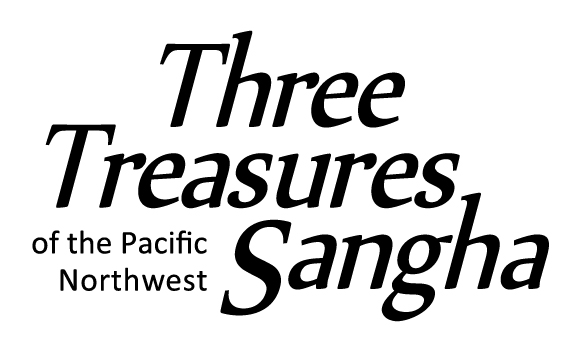 Something caught my attention that has intrigued me for a long time. Maybe it intrigues you too, and we can start walking through it here. In the Coincidence of Opposites we recite:
Something caught my attention that has intrigued me for a long time. Maybe it intrigues you too, and we can start walking through it here. In the Coincidence of Opposites we recite:
In the very midst of light, there is darkness;
don’t meet another in the darkness.
In the very midst of darkness, there is light;
don’t observe another in the light.
This doesn’t mean that we should all become hermits so we won’t see other people. Rather, our way of seeing and being in the world needs a slightly radical tune-up.
In writing on Buddha-nature in the Shōbōgenzō, Dōgen says:
The entire world is completely free of objective dust;
right here and now there is no second person!
Right here and now there is no second person. But… then… isn’t this here and now? And here we – plural – are in this room, sitting on cushions, sitting on chairs, daylight streaming in the windows, speaking with one another. Very definitely: there you are! How can I not observe another in this light? Are you really there – or not?
In speaking on Right View, the Buddha said:
Everything exists. That is one extreme,
Everything doesn’t exist. That is a second extreme.
Avoiding these two extremes,
the Tathagata teaches the Dhamma via the middle.
(Kaccayanagotta Sutta)
This middle lies between the extremes of existence and non-existence.
The Sutra on the Ultimate Truth of Emptiness puts it this way:
When the eyes see, the scene comes from nowhere.
When they shut, it goes nowhere.The Worldly Law says that
what this is, that is; this arising, that arises.
(Samyuktagama, Ch. 13)
“When the eyes see, the scene comes from nowhere.” Try it now – open, there’s the scene all right; shut – it’s gone. Attend to this as pure evidence, setting aside expectations or theories about the world.
Without expectations, the experience of eyes and the scene are inseparable…”when this is, that is.” Not only “when,” but “what this is, that is”; there is only one happening here and now, and its nature is multiplicity, appearing. When there is yellow, green, iris or rhinoceros, we say “I am seeing.” When there is singing, hooting, rustling, screeching, we say “I am hearing.” When there is tree-bark roughness, sun warmth, dog’s ear softness, wet handful of waterweed, we say “I feel,” or “I am touching.” Contacting the world and contacting ourselves is one. What we call “world” and what we call “self” co-occur simultaneously and they are the identical instant. Hence, what this (“person” or “inside”) is, that (“world” or “outside”) is. This is termed dependent origination or interdependence, and it is the middle, right between existence and non-existence. In this place of one happening constantly changing, in the middle, there is no second person.
Everyone is familiar with the middle. It is the very stuff of our everyday experience. Still, we get caught up in identifying with one side of the picture: the inside, and all our troubles break loose from there.
As an antidote to the mistaken notion that I am inside only, we are urged to be right here and now, to be in the moment. You hear it everywhere, even (ironically) in advertising. And from time to time we slip completely into it, finding then that we are – and always were – already woven into unthinkable harmony.
Be in the moment. That is, be awake to This Happening, before it is named, before it is claimed. This is the middle, neither existence nor non-existence.
Right away our thinking mind sees a way to improve things: “Oh good, all I have to do is stay in this moment and it will solve everything. I’ll just find it, stake a claim and stay there from now on.” But we can’t just freeze ourselves here “in the moment” because there is no object to be called “the moment,” and also no objectifiable person¬ to be “in” it. Moment is defined as “a particular instant in time” (as though it were a thing) – but the origin of the word is the Latin “momentum,” which means motion. No wonder we can’t point to a moment or touch it or grasp it. The thinking mind’s plans to set up camp in the moment are thwarted from the outset. The appearance of the moment is constant motion – change!
And though we think we know how it is to be a person, that turns out to be largely fictional too. What we point to when we say, “It’s me,” is what the Song of the Grass-Roof Hermitage calls a “skin bag” – and that is hardly “a person.”
With every statement that “there is no separate self-existent thing,” the ground under our feet slips a little. Like a mountain of sand, the seemingly solid world sifts into the unseen abyss through this one slight, inarguable hairline crack: “There is no separate, self-existent thing.” As we stay present, life keeps happening – changing and flowing, calling for any number of possible actions including doing nothing. This sort of being in the moment seems more like swimming or dancing, a lot more active, multidimensional and interactive than the blunt category “being in the moment” implies.
And though the Verse of the Faith Mind says of this middle, “In the dharma world of Suchness, there is no other, there is no self,” we humans still find ourselves having to negotiate social interactions. Dōgen addresses this in Four Virtues of a Bodhisattva, namely giving, kind speech, beneficial action, and cooperation.
The fourth, “cooperation,” is sometimes translated “identity-action,” an awkward but useful term. I’ve been talking about identity all along here… the eye and the scene, ear and sounds, body and tactile experience and so on are not two: they are in fact identical, an identity, from the Latin idem, the same. So the translation “identity-action” points to the quality of behavior appropriate to those who experience interdependence or emptiness clearly and want to behave in accord with that experience. Identity-action is action from the standpoint of emptiness, of not-two, of non-difference from self and non-difference from others. How does one interact socially from a nondual position?
In explaining identity-action, Dōgen emphasizes right form, dignity, and correct manner. “Right” and “correct” here don’t belong to the world of right and wrong. Instead, these words point to a quality of authenticity that takes into account the lively and constantly changing middle, that indefinable moment of presence that reveals non-difference from self and non-difference from others.
More helpful is Dōgen’s use of the word “dignity” in characterizing identity-action. The dictionary defines dignity as “poise and self-respect in one’s deportment to a degree that inspires respect.” Poise, in turn, is defined as freedom from affectation or embarrassment. Oddly appropriate, don’t you think? Affectation and embarrassment are nothing but forms of greed and hatred, or attachment and aversion, the sticky-handedness of delusion that ensnares us. Freedom from stickiness is a quality of identity-action, the way to perform social interaction while aware of non-difference. Now the translation “co-operation” (for identity-action) makes sense – functioning together. My history probably prejudiced me against this term. When I was a kid it meant “you kids get along together, or else!” emphasizing distinctions of person.
It is abundantly clear that we cannot throw ethical behavior to the winds just because we have seen through illusory aspects of phenomena. To do so is incomplete, revealing attachment to one side of emptiness, neglect of the other. Respectful interaction while on the Middle Way is itself the middle.
Part of us worries about being on the Middle Way, worries about whether this is the real path, the right path, and the possibility of falling off of it. But there is no self-existent path either. How do I not fall from the path?
Maybe a little poetry will close this appropriately.
Antonio Machado wrote:
.
Wayfarer, the only way
is your footsteps, there is no other.
Wayfarer, there is no way,
you make the way as you go.
As you go, you make the way
and stopping to look behind,
you see the path that your feet
will never travel again.
Wayfarer, there is no way —
only foam trails in the sea.
Act in this moment – and in each moment – authentically, that is, according to your nature, with right form, dignity, and respectful manner, even – especially – in conflict.
Neither Past Nor Future Is Here
What this is, that is;
the eye opens —
red leaves of the smoke bush,
clear garnet of a pomegranate seed;
pale green breeze of itching skin
walks through wild vetch
twining purple up the rampant grass.
Is there an “other”?
Ask the mossy tree stump.
No other at all?
Ask the little owl’s cry;
Ask thunder.
Talk by Madelon Bolling
